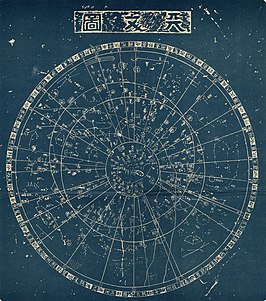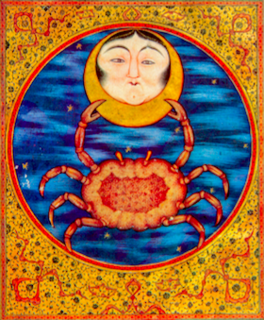
Libra is a constellation of the zodiac. Its name is Latin for weighing scales, and its symbol is . It is fairly faint, with no first magnitude stars, and lies between Virgo to the west and Scorpius to the east. Beta Librae, also known as Zubeneschamali, is the brightest star in the constellation. Three star systems are known to have planets.

Sagittarius is one of the constellations of the zodiac. It is one of the 48 constellations listed by the 2nd-century astronomer Ptolemy and remains one of the 88 modern constellations. Its name is Latin for the archer, and its symbol is , a stylized arrow. Sagittarius is commonly represented as a centaur pulling back a bow. It lies between Scorpius and Ophiuchus to the west and Capricornus and Microscopium to the east.

The zodiac is an area of the sky that extends approximately 8° north or south of the ecliptic, the apparent path of the Sun across the celestial sphere over the course of the year. The paths of the Moon and visible planets are also within the belt of the zodiac.

Traditional Chinese astronomy has a system of dividing the celestial sphere into asterisms or constellations, known as "officials".

Sidereal and tropical are astrological terms used to describe two different definitions of a year. They are also used as terms for two systems of ecliptic coordinates used in astrology. Both divide the ecliptic into a number of "signs" named after constellations, but while the sidereal system defines the signs based on the fixed stars, the tropical system defines it based on the position of vernal equinox in the northern hemisphere. Because of the precession of the equinoxes, the two systems do not remain fixed relative to each other but drift apart by about 1.4 arc degrees per century. The tropical system was adopted during the Hellenistic period and remains prevalent in Western astrology. A sidereal system is used in Hindu astrology, and in some 20th century systems of Western astrology.

Taurus Poniatovii was a constellation created by the former rector of Vilnius University, Marcin Odlanicki Poczobutt, in 1777 to honor Stanislaus Poniatowski, king of Poland. It consisted of stars that are today considered part of Ophiuchus and Aquila. It is no longer in use. It was wedged in between Ophiuchus, Aquila and Serpens Cauda. A depiction of the constellation can be found on the wall of the Vilnius University Astronomical Observatory.
V849 Ophiuchi or Nova Ophiuchi 1919 was a nova that lit up in 1919 in the constellation Ophiuchus and reached a brightness of 7.4 mag.

Cancer (♋️) is the fourth astrological sign in the Zodiac, originating from the constellation of Cancer.
It spans from 90° to 120° celestial longitude. Under the tropical zodiac, the Sun transits this area between approximately June 21 and July 23, and under the sidereal zodiac, the Sun transits this area between approximately July 21 and August 9.

Pisces (♓️) is the twelfth astrological sign in the Zodiac. It spans 330° to 360° of celestial longitude. Under the tropical zodiac, the sun transits this area between February 19 and March 20. In Sidereal astrology, the Sun currently transits the constellation of Pisces from approximately March 12 to April 18. In classical interpretations, the symbol of the fish is derived from the ichthyocentaurs, who aided Aphrodite when she was born from the sea.

Scorpio (♏) is the eighth astrological sign in the Zodiac, originating from the constellation of Scorpius. It spans 210°–240° ecliptic longitude. Under the tropical zodiac, the Sun transits this area on average from October 23 to November 22. Under the sidereal zodiac, the Sun is in Scorpio from approximately November 16 to December 15. Depending on which zodiac system one uses, an individual born under the influence of Scorpio may be called a Scorpio or a Scorpion.

Sagittarius (♐) is the ninth astrological sign, which is associated with the constellation Sagittarius and spans 240–270th degrees of the zodiac. Under the tropical zodiac, the sun transits this sign between approximately November 23 and December 21. Greek mythology associates Sagittarius with the centaur Chiron, who mentored Achilles, a Greek hero of the Trojan War, in archery.
Chinese star names are named according to ancient Chinese astronomy and astrology. The sky is divided into star mansions and asterisms. The system of 283 asterisms under Three Enclosures and Twenty-eight Mansions was established by Chen Zhuo of the Three Kingdoms period, who synthesized ancient constellations and the asterisms created by early astronomers Shi Shen, Gan De and Wuxian. Since the Han and Jin Dynasties, stars have been given reference numbers within their asterisms in a system similar to the Bayer or Flamsteed designations, so that individual stars can be identified. For example, Deneb is referred to as 天津四.

Virgo (♍), is the sixth astrological sign in the Zodiac. It spans the 150-180th degree of the zodiac. Under the tropical zodiac, the Sun transits this area on average between August 23 and September 22, and the Sun transits the constellation of Virgo from approximately September 16 to October 30. Individuals born during these dates, depending on which system of astrology they subscribe to, may be called Virgos or Virgoans. The symbol of the maiden is based on Astraea. In Greek mythology, she was the last immortal to abandon Earth at the end of the Silver Age, when the gods fled to Olympus – hence the sign's association with Earth.

Libra (♎) is the seventh astrological sign in the Zodiac.
It spans 180°–210° celestial longitude. Under the tropical zodiac, the Sun transits this area on average between September 23 and October 23, and under the sidereal zodiac, the sun currently transits the constellation of Libra from approximately October 31 to November 22. The symbol of the scales is based on the Scales of Justice held by Themis, the Greek personification of divine law and custom. She became the inspiration for modern depictions of Lady Justice. The ruling planet of Libra is Venus. Libra and Aquarius are the only zodiac constellations in the sky represented by inanimate objects. The other eleven signs are represented either as an animal or mythological characters throughout history.

Capricorn (♑) is the tenth astrological sign in the zodiac, originating from the constellation of Capricornus, the horned goat. It spans the 270–300th degree of the zodiac, corresponding to celestial longitude. Under the tropical zodiac, the sun transits this area from about December 22 to January 19 the following year, and under the sidereal zodiac, the sun transits the constellation of Capricorn from approximately January 16 to February 16. In astrology, Capricorn is considered an earth sign, negative sign, and one of the four cardinal signs. Capricorn is said to be ruled by the planet Saturn. In Vedic Astrology Capricorn was associated with the Crocodile but modern astrologers consider Capricorn as Sea goat.
Its symbol is based on the Sumerians' primordial god of wisdom and waters, Enki, with the head and upper body of a goat and the lower body and tail of a fish. Later known as Ea in Akkadian and Babylonian mythology, Enki was the god of intelligence, creation, crafts; magic; water, seawater and lakewater.
Walter Berg is a British astrologer, known for his system of a 13-sign sidereal astrology (13), "a sidereal system that uses the actual star constellations of the true zodiac".

Vasilis A. Kanatas is a Greek physicist.














